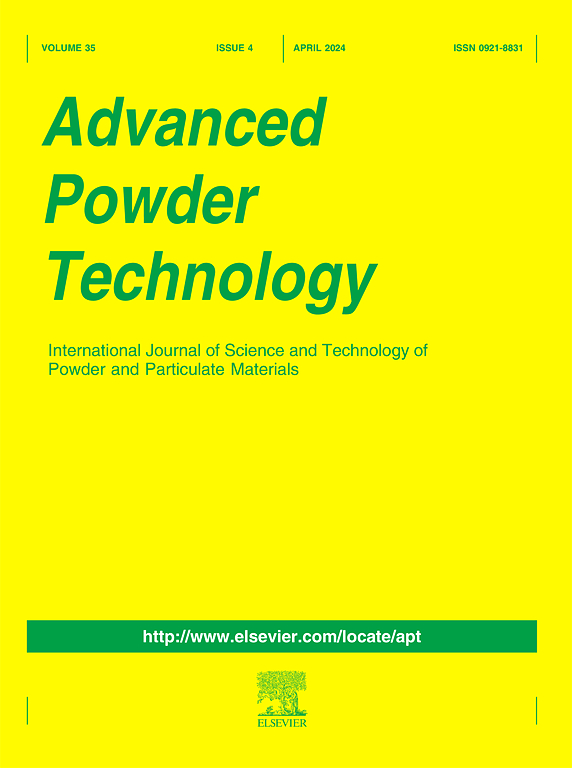磷石膏基抑爆剂的研制,降低粉尘爆炸的严重程度
IF 4.2
2区 工程技术
Q2 ENGINEERING, CHEMICAL
引用次数: 0
摘要
本研究以工业废磷石膏(PG)渗滤液为原料,通过反应体系调整和共沉淀反应制备磷酸铵镁(MAP)粉末抑制剂,实现了废料的回收再利用。在20 l球形爆炸容器和1.2 l哈特曼管中研究了MAP粉末抑制剂对丁腈橡胶粉尘爆炸的影响。结果表明,MAP对丁腈橡胶粉尘爆炸有明显的抑制作用。MAP添加量为70%时,NBR粉尘的最大爆炸压力(Pmax)由4.8 bar降至1.55 bar,爆炸指数(KSt)由35.75 bar·m·s−1降至10.61 bar·m·s−1。当掺量为90%时,丁腈橡胶粉尘爆炸可被完全抑制。此外,添加50% MAP后,NBR粉尘的点火时间延迟了7 ms,粉尘爆炸最大火焰瞬间到完全熄灭的时间从515 ms缩短到306 ms,火焰亮度和火焰面积均有所减小。热分析研究表明,MAP消粉剂的抑爆机理主要是通过物理和化学两方面,包括物理屏障作用、吸热冷却作用和自由基消耗作用。本文章由计算机程序翻译,如有差异,请以英文原文为准。

Preparation of phosphogypsum-based explosion suppressant to reduce the severity of dust explosions
This study utilizes industrial waste phosphogypsum (PG) leachate as the raw material to prepare a magnesium ammonium phosphate (MAP) powder suppressant through reaction system adjustment and coprecipitation reactions, achieving the recycling and reuse of waste materials. The impact of the MAP powder suppressant on the explosion of nitrile butadiene rubber (NBR) dust was investigated in a 20-L spherical explosion vessel and a 1.2-L Hartmann tube. The results indicated that MAP has significant suppression effect on NBR dust explosion. When 70 % MAP was added, the maximum explosion pressure (Pmax) of NBR dust decreased from 4.8 to 1.55 bar, and the explosion index (KSt) dropped from 35.75 to 10.61 bar·m·s−1. When 90 % MAP was added, the NBR dust explosion can be completely suppressed. Additionally, with the addition of 50 % MAP, the ignition time of NBR dust was delayed by 7 ms, the duration from the maximum flame moment of the dust explosion to complete flame extinction decreased from 515 to 306 ms, and both the flame brightness and flame area were also reduced. Thermal analysis research showed that the explosion suppression mechanism of MAP powder suppressant is mainly through physical and chemical aspects, including effects of physical barrier, endothermic cooling and consumption of free radicals.
求助全文
通过发布文献求助,成功后即可免费获取论文全文。
去求助
来源期刊

Advanced Powder Technology
工程技术-工程:化工
CiteScore
9.50
自引率
7.70%
发文量
424
审稿时长
55 days
期刊介绍:
The aim of Advanced Powder Technology is to meet the demand for an international journal that integrates all aspects of science and technology research on powder and particulate materials. The journal fulfills this purpose by publishing original research papers, rapid communications, reviews, and translated articles by prominent researchers worldwide.
The editorial work of Advanced Powder Technology, which was founded as the International Journal of the Society of Powder Technology, Japan, is now shared by distinguished board members, who operate in a unique framework designed to respond to the increasing global demand for articles on not only powder and particles, but also on various materials produced from them.
Advanced Powder Technology covers various areas, but a discussion of powder and particles is required in articles. Topics include: Production of powder and particulate materials in gases and liquids(nanoparticles, fine ceramics, pharmaceuticals, novel functional materials, etc.); Aerosol and colloidal processing; Powder and particle characterization; Dynamics and phenomena; Calculation and simulation (CFD, DEM, Monte Carlo method, population balance, etc.); Measurement and control of powder processes; Particle modification; Comminution; Powder handling and operations (storage, transport, granulation, separation, fluidization, etc.)
 求助内容:
求助内容: 应助结果提醒方式:
应助结果提醒方式:


